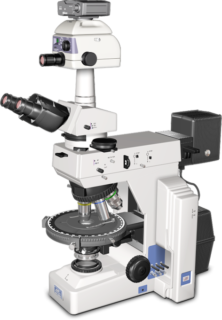Nikon’s Museum of Microscopy
Eclipse E600
( early 1990s )
Nikon's Eclipse E600 research microscope is equipped with the revolutionary CFI60 infinity optical system, providing bright, sharp, crisp and clear images in all applications.

Available since the mid-1990s, the mid-tier microscope incorporates completely new specifications adopted for the CFI60 series objectives, including a 60-millimeter parfocal distance, a 25-millimeter thread size, and a standard 22-millimeter field of view. An ergonomic design allows for longer periods of comfortable observation.
The E600 is equipped with a detachable substage, a 12-volt 100-watt tungsten-halide lamp, filter magazine, and a choice of sextuple nosepiece or sextuple DIC nosepiece. The microscope features a longer focal length tube lens, a characteristic feature of the new CFI60 infinity optical system, and a new multiple point rigid design for attaching accessories. Advanced universal objectives allow for multiple observation techniques -- such as brightfield, darkfield, Nomarski DIC, epi-fluorescence or phase contrast -- eliminating the need to change objectives while maintaining the same optical quality as dedicated lenses.
Main components of the CFI60 infinity optical system include the objective, a tube lens to converge the light beam, and an eyepiece lens to enlarge the intermediate image, all with the absence of significant optical aberration. A parallel optical path exists between the objective and the tube lens, which allows auxiliary modules, such as an epi-fluorescence illuminator or polarizing intermediate tube to be placed in the optical path in order to create a flexible modern microscope system without additional relay optics.
Infinity or parallel light beams offer an intrinsic design advantage in that they are relatively insensitive to placement of additional optical components in the telescopic space between the objective and the tube lens. So long as they are plane parallel, infinity beams are not affected by the thickness of components, such as filters, analyzers, compensators, DIC prisms, and reflectors. The location of the image point remains constant, both axially and laterally, as does the alignment between the objective and the tube lens.
The E600 incorporates a number of ergonomic features. The angle of the eyepiece tube is lower than on conventional models, only 25 degrees up from horizontal, assuring better posture for the operator. An optional riser allows taller operators to increase the height of the eyepiece by as much as 100 millimeters. The stage height is 200 millimeters lower than on conventional models, facilitating smooth nosepiece rotation and specimen handling for faster, more efficient, strain-free operation. The stage handle and the focus control knob are equidistant from the operator and positioned so the operator's hands can rest on the desk. The main switches and controls are located in the front for easy access. The design of the fine focus knob and the stage handle enable the user to make adjustments with one hand leaving the second hand free for other tasks.
Today the Eclipse E600 is succeeded by the Eclipse Ni-U and Eclipse Ci Series upright microscopes.













